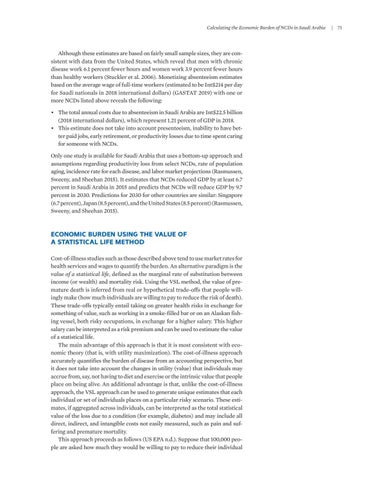Calculating the Economic Burden of NCDs in Saudi Arabia | 71
Although these estimates are based on fairly small sample sizes, they are consistent with data from the United States, which reveal that men with chronic disease work 6.1 percent fewer hours and women work 3.9 percent fewer hours than healthy workers (Stuckler et al. 2006). Monetizing absenteeism estimates based on the average wage of full-time workers (estimated to be Int$214 per day for Saudi nationals in 2018 international dollars) (GASTAT 2019) with one or more NCDs listed above reveals the following: • The total annual costs due to absenteeism in Saudi Arabia are Int$22.5 billion (2018 international dollars), which represent 1.21 percent of GDP in 2018. • This estimate does not take into account presenteeism, inability to have better paid jobs, early retirement, or productivity losses due to time spent caring for someone with NCDs. Only one study is available for Saudi Arabia that uses a bottom-up approach and assumptions regarding productivity loss from select NCDs, rate of population aging, incidence rate for each disease, and labor market projections (Rasmussen, Sweeny, and Sheehan 2015). It estimates that NCDs reduced GDP by at least 6.7 percent in Saudi Arabia in 2015 and predicts that NCDs will reduce GDP by 9.7 percent in 2030. Predictions for 2030 for other countries are similar: Singapore (6.7 percent), Japan (8.5 percent), and the United States (8.5 percent) (Rasmussen, Sweeny, and Sheehan 2015).
ECONOMIC BURDEN USING THE VALUE OF A STATISTICAL LIFE METHOD Cost-of-illness studies such as those described above tend to use market rates for health services and wages to quantify the burden. An alternative paradigm is the value of a statistical life, defined as the marginal rate of substitution between income (or wealth) and mortality risk. Using the VSL method, the value of premature death is inferred from real or hypothetical trade-offs that people willingly make (how much individuals are willing to pay to reduce the risk of death). These trade-offs typically entail taking on greater health risks in exchange for something of value, such as working in a smoke-filled bar or on an Alaskan fishing vessel, both risky occupations, in exchange for a higher salary. This higher salary can be interpreted as a risk premium and can be used to estimate the value of a statistical life. The main advantage of this approach is that it is most consistent with economic theory (that is, with utility maximization). The cost-of-illness approach accurately quantifies the burden of disease from an accounting perspective, but it does not take into account the changes in utility (value) that individuals may accrue from, say, not having to diet and exercise or the intrinsic value that people place on being alive. An additional advantage is that, unlike the cost-of-illness approach, the VSL approach can be used to generate unique estimates that each individual or set of individuals places on a particular risky scenario. These estimates, if aggregated across individuals, can be interpreted as the total statistical value of the loss due to a condition (for example, diabetes) and may include all direct, indirect, and intangible costs not easily measured, such as pain and suffering and premature mortality. This approach proceeds as follows (US EPA n.d.). Suppose that 100,000 people are asked how much they would be willing to pay to reduce their individual

